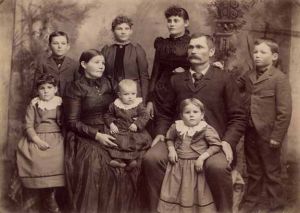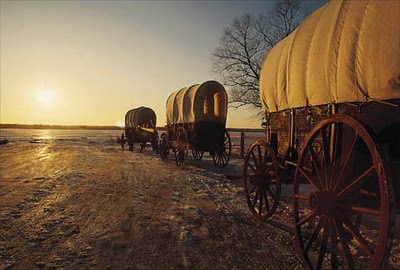The trail which the early Mormon pioneers forged through sweat, tears, and oftentimes at the cost of life itself, was an arduous one at best for both adults and children. In spite of all their hardships, they never lost faith, but with every footstep remained stalwart as they trekked to the land that would become known to them as Zion.
Sadly, many of the children would lose their parents to death along the trail. However, even in their final moments, their parents’ hopes and prayers were that their progeny would reach Zion and have a better life for themselves and all future generations. In such times, these children were robbed of the innocence of their youth as they were forced to mature and take on adult responsibilities at an early age. Nevertheless, they were determined to fulfill their parents’ desires, and continued the journey, albeit with heavy hearts. Along the way, many of the children would have stories of their own to tell about their experiences.
Mormon Children on the Pioneer Trail
 Twelve-year-old Albert Dickson was one of thousands of Mormon children who migrated to the west in the late 1840’s and early 1850’s. He was the second oldest of 5 children. His other siblings, his fourteen-year-old sister, Samantha; his nine-year-old brother, Judson; Alvina, who was six; and two-year-old William were also on the journey which covered an average of ten to fifteen miles each day depending on weather and the terrain, with only approximately half that distance traveled once they reached the Rocky Mountains.
Twelve-year-old Albert Dickson was one of thousands of Mormon children who migrated to the west in the late 1840’s and early 1850’s. He was the second oldest of 5 children. His other siblings, his fourteen-year-old sister, Samantha; his nine-year-old brother, Judson; Alvina, who was six; and two-year-old William were also on the journey which covered an average of ten to fifteen miles each day depending on weather and the terrain, with only approximately half that distance traveled once they reached the Rocky Mountains.
Albert recorded the following in his journal:
We crossed the Missouri on a large flatboat. Two wagons went on each trip, with three men to the oar and one at the rear to steer. They would land down the river about one mile from the starting point, then pull the boat back with oxen.
When the entire party, which consisted of 60 wagons, had gathered on the other side of the river, they were divided into groups of ten with a captain appointed as leader of each group. Children comprised at least half of the company. The older children usually walked beside the wagons, with some being given the responsibility to herd the sheep. The younger children also walked during part of the day, but were allowed to ride in the wagons as they grew weary.
According to the article by Fay McCracken titled “Children Pioneers” in the July 1995 issue of the Friend magazine:
The group followed the Mormon Trail, which had been cleared in 1847 as a route for the migration of Church members to the Salt Lake Valley. It followed the north side of the Platte River to the fork of the North Platte and South Platte, then ran along the North Platte to Fort Laramie, where the pioneers crossed the river and followed the Oregon Trail to Fort Bridger. From there they traveled down Weber Canyon and Emigration Canyon into the Salt Lake Valley. The entire trip was about 1100 miles.
The company that Albert and his family traveled with was the fourteenth to leave for the west that spring, and the trail which the pioneers traversed was well marked and well-traveled. As the pioneers continued their trek westward, one of the first challenges that they faced was disease such as cholera which affected adults and children alike. Two members of the company succumbed to the disease at the first camp on the Platte River, and by the time they reached Loup Fork, a total of twelve would die from the dreaded disease.
With the large number of buffalo that were sited on the trail, buffalo meat soon became a staple, and oftentimes members of the company would leave messages on buffalo skulls for those yet to come.
Contrary to many wise tales, although Indian tribes were encountered along the way, they never presented much of a problem to the Mormon pioneers. In fact, they would often visit the camps and were given gifts such as beads and fishhooks. Because of the hospitality that was shown to them, the Indians did not attack the wagon trains.
Remembering the Sabbath Day
 The wagon train would often stop and camp for a day or two to rest the animals, repair wagons, and do laundry. The older boys in the camp were expected to work with the men and help to get camp chores done. Albert worked alongside his father, Billa Dickson, who was a blacksmith by trade, and whose services were often called upon to repair wagon wheels and axles. He also hunted for fresh meat for the camp with his father.
The wagon train would often stop and camp for a day or two to rest the animals, repair wagons, and do laundry. The older boys in the camp were expected to work with the men and help to get camp chores done. Albert worked alongside his father, Billa Dickson, who was a blacksmith by trade, and whose services were often called upon to repair wagon wheels and axles. He also hunted for fresh meat for the camp with his father.
Although the rigors of the journey were long and hard, the Mormon pioneers always remembered to take time to observe the Sabbath. The rest from the arduous journey was welcomed by everyone, especially the children as they attended Sunday school with their friends, sang songs, listened to stories, visited with the other children, and explored the nearby countryside.
They the Builders of the Nation
The company reached their halfway point, Fort Laramie by midsummer, and on the first of October, they entered the Salt Lake Valley – their new home – Zion.
Mormon Pioneer Children Became Leaders in Utah
Usually when a person thinks about Mormon pioneers, they are more familiar with the stories of the adults that made the trek to the west. However, a majority of the western pioneers were actually young children like Albert Dickson who eventually moved to Morgan County where he became the first Bishop of the Richville Ward, and served for 37 years. As these pioneer children grew older, they became the builders and leaders of thriving communities. They literally became the builders of a great nation which was forged out of barren and hostile lands. Their skills and leadership abilities were partially developed during their trek to Zion.
About Keith L. Brown
Keith L. Brown is a convert to The Church of Jesus Christ of Latter-day Saints, having been born and raised Baptist. He was studying to be a Baptist minister at the time of his conversion to the LDS faith. He was baptized on 10 March 1998 in Reykjavik, Iceland while serving on active duty in the United States Navy in Keflavic, Iceland. He currently serves as the First Assistant to the High Priest Group for the Annapolis, Maryland Ward. He is a 30-year honorably retired United States Navy Veteran.


 Watch a video about the restoration of the gospel on lds.org
Watch a video about the restoration of the gospel on lds.org